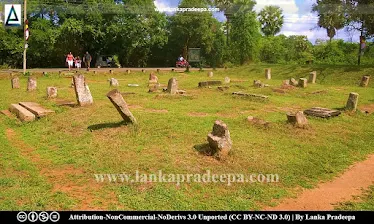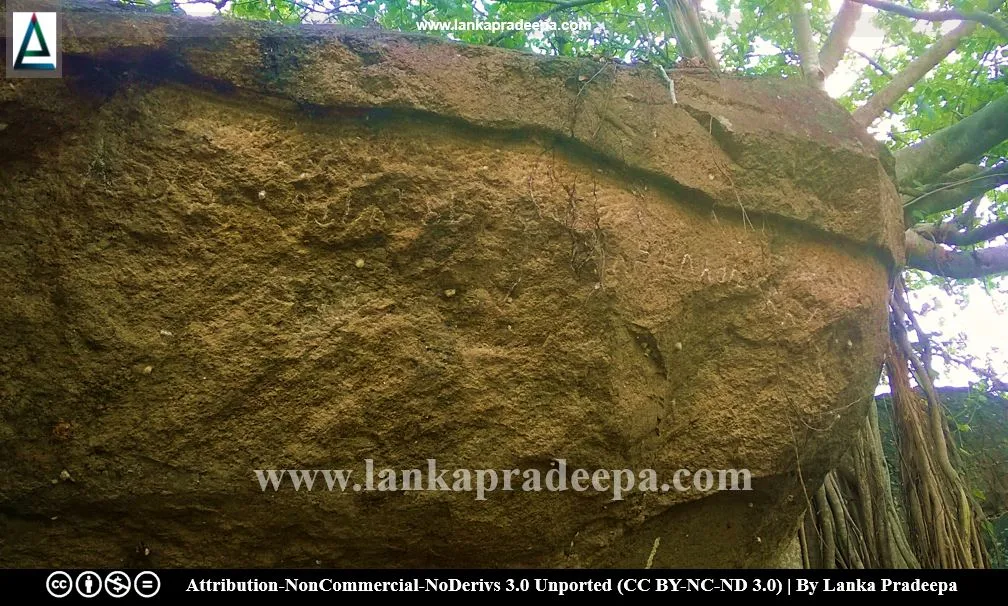
Vessagiriya (Sinhala: වෙස්සගිරිය; Tamil: வெஸ்ஸகிரிய) is a ruined Buddhist cave monastery site located in Anuradhapura District, Sri Lanka. It is believed to be the ancient Issarasamana Vihara founded by King Devanampiyatissa [(247-207 B.C.) Nicholas, 1963; Paranavitana, 1953].
The site
Vessagiriya is located about a mile to the southwest of Jaya Sri Maha Bodhiya. Three clusters of rocks, surrounded by structural ruins of an ancient monastery are identified at the location. About 23 caves prepared as dwells for Buddhist monks are found at the site. Several caves bear Early Brahmi Inscriptions of the pre-Christian era inscribed on the brows of the caves just below the "Katarama" (drip-ledge), marking the name of the donors who had donated the caves to the monks.
Vessagiriya Cave Inscriptions

Transcript: Parumaka Palikada putha upasaka Harumasa lene catudisa shagasa
Translation: The cave of the lay devotee Haruma, son of his eminence Palikada, (is dedicated) to the (Buddhist) priesthood of four quarters.
Transcription: Tuladara nagaya putha devaha lene agata anagata catudisha shagasha
Translation: The cave of Deva, son of Tuladara Naga, (is given) to the (Buddhist) priesthood of the four quarters, present and not present
Transcription: Parumaka Palikadasa bariya Parumaka shurakita jhita upashika Citaya lene shagasha chatudisha
Translation: The cave of female devotee Cita (Citra), daughter of his eminence Shurakita and wife of his eminence Palikada, (is dedicated) to the (Buddhist) priesthood of the four quarters
Reference: Wickremasinghe, 1912. p. 19.

.


.
History
Ancient Vessgiriya
Vessagiriya is one of the shrines built by King Davanampiya Tissa (Mahawamsa: ch. XX: 15-20). The chronicle Mahawamsa gives an account of the shrines built by Devanampiyatssa in which the shrine Vessagiriya is mentioned as the ninth in the order of description. According to the chronicle, Vessagiriya got its name from the 500 Vaisyas (commoners) who lived there, after they had been ordained by Mahinda Thera (Wickremasinghe, 1912).
Vessagiriya is one of the shrines built by King Davanampiya Tissa (Mahawamsa: ch. XX: 15-20). The chronicle Mahawamsa gives an account of the shrines built by Devanampiyatssa in which the shrine Vessagiriya is mentioned as the ninth in the order of description. According to the chronicle, Vessagiriya got its name from the 500 Vaisyas (commoners) who lived there, after they had been ordained by Mahinda Thera (Wickremasinghe, 1912).
The name Vessagiriya is mentioned again in the chronicle Mahawamsa in connection with King Vattagamini Abhaya (King Valagamba 103, 89-77 B.C.). After being defeated by Tamils in battle, King Valagamba fled his capital and found refuge in the Vessagiriya forest where he met Kutthikula Mahatissa Thera, the then-abbot of the forest monastery (Wickremasinghe, 1912).
However there is uncertainty among scholars regarding the location of the ancient Vessagiriya monastery,
The ancient Vessagiri Vihara founded by Devanampiya Tissa is certainly not the cave monastery in the southern part of Anuradhapura which now bears this name: inscriptions in-situ identify modern Vessagiriya with the ancient Issarasamana Vihara. Historically, too, the situation of Vessagiri could be inferred to be several miles south of Anuradhapura, because Vattagamini Abhaya, fleeing after his defeat in the northern suburbs of the city, took refuge in the Vessagiriya forest: and modern Vessagiriya or its vicinity was no place of refuge for a king fleeing from an enemy in occupation of his capital.Citation: Nicholas, 1963. p. 98.
The location of the ancient Vessagiriya monastery, according to some, is somewhere in Dambulla (Gamage, 1987; Perera, 1970).

Ancient Issarasamana Viharaya
The ancient Issarasamana Viharaya founded by King Devanampiyatissa is believed to be the site presently known as Vessagiriya (Nicholas, 1963; Paranavitana, 1953). However, some consider that modern Isurumuniya as the ancient Issarasamana Viharaya mentioned by the chronicles (Gamage, 1987; Perera, 1970).
Issarasamana Viharaya received its name from the 500 disciples of Prince Arittha who dwelt there after they had been ordained by Mahinda Thera (Gamage, 1987). According to chronicles, one of eight saplings of the Sri Maha Bodhi Tree has been planted on this site (Gamage, 1987).
The ancient Issarasamana Viharaya founded by King Devanampiyatissa is believed to be the site presently known as Vessagiriya (Nicholas, 1963; Paranavitana, 1953). However, some consider that modern Isurumuniya as the ancient Issarasamana Viharaya mentioned by the chronicles (Gamage, 1987; Perera, 1970).
Issarasamana Viharaya received its name from the 500 disciples of Prince Arittha who dwelt there after they had been ordained by Mahinda Thera (Gamage, 1987). According to chronicles, one of eight saplings of the Sri Maha Bodhi Tree has been planted on this site (Gamage, 1987).
The name Isiramana (Pali: Issarasamana; Modern Sinhala: Isurumuniya) Viharaya is mentioned in several inscriptions of the 1st, 2nd, and 3rd centuries A.D. found in the modern Vessagiriya temple. Issarasamana Viharaya, throughout history, has received the patronage of kings. King Chandra-Mukhasiva (43-52 A.D.) built a tank in
Manikaragama and bestowed it for the usage of this temple (Gamage,
1987). During the reign of King Vasabha (67-111 A.D.)
an Uposatha House
was added to this temple and a wall had been also added to it by King
Voharika Tissa [(209-231 A.D.) Gamage, 1987; Nicholas, 1963].
The temple was repaired and enlarged in the 5th century A.D. by King
Kassapa I [(473-491 A.D.) Gamage, 1987; Nicholas, 1963; Paranavitana, 1953].
According to Mahawamsa, King Kassapa I renovated the Issarasamana temple and renamed as Bo-Upulvan Kasubgiri Viharaya, giving it his own name and the names of his daughters Bodhi and Uppalavanna (Gamage, 1987). This fact given in the Mahawamsa is confirmed by the inscriptions found in the
modern Vessagiriya Vihara premises (Nicholas, 1963).
- Vessagiriya Rock InscriptionsTranscript: Latakatala(hi) oluvadu Puyagonu-lami B(o)ya Opulavana Kasapi ga-ri raja maha vahere siya agana vahara-la cidavi ma pala sava satanataTranslation: Puyagonula, the bricklayer of Latakatala, caused my wife to be freed from slavery in the royal monastery of Boya-Opulavana-Kasapi-gari. (May) the fruit of this (action be) for the benefit of all beings.Reference: Paranavitana, 1934
- Vessagiriya Rock InscriptionsTranscript: Sahasavarala Dalameya Sakanakana-Vesiminiya Aba Kasaba-giriye va-hara sayaka kahavana di vaharila cidava-yaha maha pala sava satanataTranslation: Sahasavarala Dalameya and Sakanakana Vesaminiya Aba gave a hundred Kahapanas to the Kasabagiriye monastery and freed (themselves) from slavery. May the fruit of this (action) be for the benefit of all beings.Reference: Paranavitana, 1934
.
The renamed temple was then started to be known by chronicles as Kassapagiri Viharaya (Nicholas, 1963). The temple was endowed during the reigns of King Jettatissa III (628 A.D.) and King Dathopatissa II (659-667 A.D.). A Maha-Pasada had been added to the temple by King Mahinda IV [(956-972 A.D.) Nicholas, 1963].


.
Attribution
References
1) Gamage, D., 1987. ඉසුරුමුණි විහාරයේ මිනිසා සහ අශ්ව හිස පිළිබද නව
සංකල්පයක් (In Sinhala). Vidyodaya J., Soc., Sc. Vol. 1. No.1. pp.47-58.
2) Nicholas, C. W., 1963. Historical topography of ancient and medieval Ceylon. Journal of the Ceylon Branch of the Royal Asiatic Society, New Series, vol VI, Special Number: Colombo. Royal Asiatic Society (Ceylon Branch). pp.98, 148-149
3) Paranavitana, S.; Codrington. H. W., 1934. Epigraphia Zeylanica: Being lithic and other inscription of Ceylon (Vol. IV). London. Archaeological Survey of Ceylon. pp.132-133.
4) Paranavitana, S., 1953. The Sculpture of Man and Horse near Tisāväva at Anurādhapura, Ceylon. Artibus Asiae, pp.167-190.
5) Perera, A.D.T.E., 1970. A Possible Identification of a Significant Sculpture at Isurumuniya Temple, Anurādhapura A Man and a Horse's Head. East and West, 20(1/2), pp.122-143.
6) Wickremasinghe, D.M.D.Z., 1912. Epigraphia Zeylanica: Being lithic and other inscription of Ceylon (Vol. I). London. Archaeological Survey of Ceylon. pp.10-20.
4) Paranavitana, S., 1953. The Sculpture of Man and Horse near Tisāväva at Anurādhapura, Ceylon. Artibus Asiae, pp.167-190.
5) Perera, A.D.T.E., 1970. A Possible Identification of a Significant Sculpture at Isurumuniya Temple, Anurādhapura A Man and a Horse's Head. East and West, 20(1/2), pp.122-143.
6) Wickremasinghe, D.M.D.Z., 1912. Epigraphia Zeylanica: Being lithic and other inscription of Ceylon (Vol. I). London. Archaeological Survey of Ceylon. pp.10-20.
Explore Other Nearby Attractions
Location Map (Google)
This page was last updated on 29 September 2023

